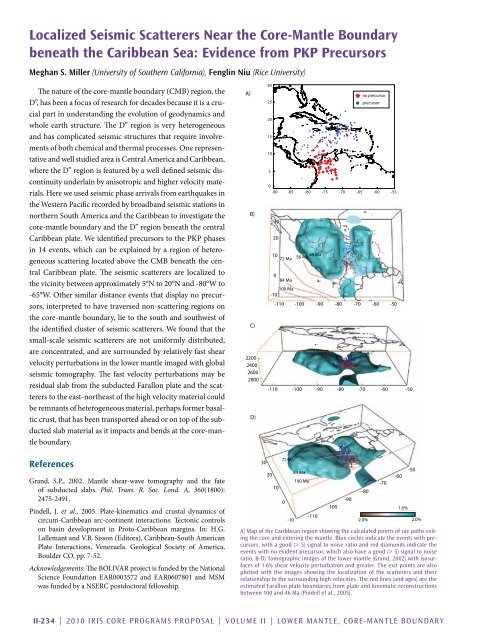Download Volume II Accomplisments (28 Mb pdf). - IRIS
Download Volume II Accomplisments (28 Mb pdf). - IRIS
Download Volume II Accomplisments (28 Mb pdf). - IRIS
You also want an ePaper? Increase the reach of your titles
YUMPU automatically turns print PDFs into web optimized ePapers that Google loves.
Localized Seismic Scatterers Near the Core-Mantle Boundary<br />
beneath the Caribbean Sea: Evidence from PKP Precursors<br />
Meghan S. Miller (University of Southern California), Fenglin Niu (Rice University)<br />
The nature of the core-mantle boundary (CMB) region, the<br />
D”, has been a focus of research for decades because it is a crucial<br />
part in understanding the evolution of geodynamics and<br />
whole earth structure. The D” region is very heterogeneous<br />
and has complicated seismic structures that require involvements<br />
of both chemical and thermal processes. One representative<br />
and well studied area is Central America and Caribbean,<br />
where the D” region is featured by a well defined seismic discontinuity<br />
underlain by anisotropic and higher velocity materials.<br />
Here we used seismic phase arrivals from earthquakes in<br />
the Western Pacific recorded by broadband seismic stations in<br />
northern South America and the Caribbean to investigate the<br />
core-mantle boundary and the D” region beneath the central<br />
Caribbean plate. We identified precursors to the PKP phases<br />
in 14 events, which can be explained by a region of heterogeneous<br />
scattering located above the CMB beneath the central<br />
Caribbean plate. The seismic scatterers are localized to<br />
the vicinity between approximately 5°N to 20°N and -80°W to<br />
-65°W. Other similar distance events that display no precursors,<br />
interpreted to have traversed non-scattering regions on<br />
the core-mantle boundary, lie to the south and southwest of<br />
the identified cluster of seismic scatterers. We found that the<br />
small-scale seismic scatterers are not uniformly distributed,<br />
are concentrated, and are surrounded by relatively fast shear<br />
velocity perturbations in the lower mantle imaged with global<br />
seismic tomography. The fast velocity perturbations may be<br />
residual slab from the subducted Farallon plate and the scatterers<br />
to the east-northeast of the high velocity material could<br />
be remnants of heterogeneous material, perhaps former basaltic<br />
crust, that has been transported ahead or on top of the subducted<br />
slab material as it impacts and bends at the core-mantle<br />
boundary.<br />
A)<br />
B)<br />
C)<br />
2200<br />
2400<br />
2600<br />
<strong>28</strong>00<br />
D)<br />
30<br />
25<br />
20<br />
15<br />
10<br />
5<br />
30<br />
20<br />
10<br />
0<br />
84 Ma<br />
100 Ma<br />
-10<br />
-110 -100<br />
-90<br />
-80<br />
-110 -100 -90 -80 -70 -60 -50<br />
-70<br />
no precursor<br />
precursor<br />
0<br />
-90 -85 -80 -75 -70 -65 -60 -55<br />
-60<br />
-50<br />
72 Ma 56 Ma 46 Ma -2.0% 2.0%<br />
References<br />
Grand, S.P., 2002. Mantle shear-wave tomography and the fate<br />
of subducted slabs. Phil. Trans. R. Soc. Lond. A, 360(1800):<br />
2475-2491.<br />
Pindell, J. et al., 2005. Plate-kinematics and crustal dynamics of<br />
circum-Caribbean arc-continent interactions: Tectonic controls<br />
on basin development in Proto-Caribbean margins. In: H.G.<br />
Lallemant and V.B. Sisson (Editors), Caribbean-South American<br />
Plate Interactions, Venezuela. Geological Society of America,<br />
Boulder CO, pp. 7-52.<br />
Acknowledgements: The BOLIVAR project is funded by the National<br />
Science Foundation EAR0003572 and EAR0607801 and MSM<br />
was funded by a NSERC postdoctoral fellowship.<br />
30<br />
20<br />
10<br />
72 Ma<br />
0<br />
-10<br />
84 Ma<br />
100 Ma<br />
-110<br />
-100<br />
A) Map of the Caribbean region showing the calculated points of ray paths exiting<br />
the core and entering the mantle. Blue circles indicate the events with precursors,<br />
with a good (> 5) signal to noise ratio and red diamonds indicate the<br />
events with no evident precursor, which also have a good (> 5) signal to noise<br />
ratio. B-D) Tomographic images of the lower mantle (Grand, 2002) with isosurfaces<br />
of 1.6% shear velocity perturbation and greater. The exit points are also<br />
plotted with the images showing the localization of the scatterers and their<br />
relationship to the surrounding high velocities. The red lines (and ages) are the<br />
estimated Farallon plate boundaries from plate and kinematic reconstructions<br />
between 100 and 46 Ma (Pindell et al., 2005).<br />
-90<br />
-80<br />
-70<br />
-60<br />
1.6%<br />
-50<br />
<strong>II</strong>-234 | 2010 <strong>IRIS</strong> Core Programs Proposal | <strong>Volume</strong> <strong>II</strong> | Lower Mantle, Core-Mantle Boundary
















